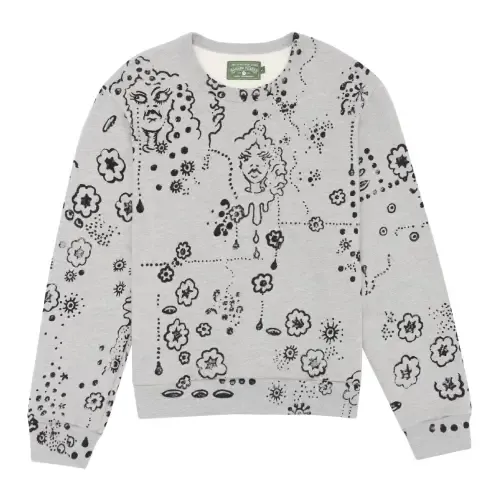
The sweatshirt, in its simplicity, has become one of the most democratic and essential garments in modern fashion. What began as a humble piece of athletic wear has evolved into a symbol of street culture, protest, and casual luxury. But when reimagined by Tremaine Emory, founder of Denim Tears sweatshirt becomes far more than a comfortable layering piece. It becomes a wearable canvas of history, identity, and cultural resistance.
The Denim Tears Sweatshirt stands as an iconic fusion of everyday comfort and historical storytelling. Its fabric is soft and familiar, but its imagery is powerful, provocative, and unforgettable. In the same way Denim Tears Jeans challenged denim’s history, the sweatshirt challenges the notion of casualwear as “neutral.” Through cotton wreaths, Pan-African colors, and bold graphics, the Denim Tears Sweatshirt transforms a garment of relaxation into one of awareness and remembrance.
1. The Sweatshirt as Cultural Canvas
Before understanding what makes the Denim Tears Sweatshirt iconic, we need to explore the history of the sweatshirt itself.
-
Origins in Sportswear
The sweatshirt was invented in the 1920s by Benjamin Russell Jr., a football player frustrated by itchy wool uniforms. He created a softer cotton alternative, birthing the modern sweatshirt. -
Adopted by Athletes & Universities
By the mid-20th century, sweatshirts became the uniform of athletes and college students, often emblazoned with school logos. -
Counterculture & Streetwear
From the 1970s onward, sweatshirts migrated from gyms to streets. Hip-hop, skate, and graffiti cultures embraced them as versatile canvases for self-expression. -
Luxury & Modern Fashion
Today, the sweatshirt bridges luxury and streetwear. It’s been reimagined by brands from Champion to Dior, Balenciaga to Supreme.
This evolution makes the sweatshirt a blank canvas of culture. It is both ordinary and extraordinary—functional yet symbolic. This duality makes it the perfect base for Denim Tears’ storytelling.
2. Tremaine Emory’s Vision
Tremaine Emory’s Denim Tears project is rooted in storytelling. As a creative director, designer, and cultural thinker, Emory has always believed that fashion should say something. The Denim Tears Sweatshirt embodies his vision: take a garment of comfort and neutrality, and force it to confront history.
Through Denim Tears, Emory embeds the narrative of African diasporic identity into clothing. Each sweatshirt serves as a cultural archive, weaving together themes of slavery, resilience, resistance, and pride. By doing so, he transforms casualwear into a site of reflection, education, and empowerment.
3. The Design Language of the Denim Tears Sweatshirt
What makes the sweatshirt so iconic is its visual identity and symbolic depth.
-
The Cotton Wreath Print
Like the jeans and hoodies, many Denim Tears Sweatshirts feature the iconic cotton wreath print. At first glance, it resembles flowers, but the motif represents cotton—the crop that enslaved Africans were forced to harvest in America. By placing cotton across the sweatshirt, Emory confronts its history. Yet, he also reclaims it, transforming a symbol of pain into one of resilience and cultural pride. -
Pan-African Influence
Some sweatshirts incorporate red, green, and black—the Pan-African flag colors. Red for blood, black for the people, and green for the land. These hues make the sweatshirt a global declaration of unity and strength. -
Typography & Statements
Certain sweatshirts feature text graphics—phrases tied to protest, remembrance, or Pan-African thought. These make the sweatshirt not just a fashion item, but a wearable manifesto. -
Silhouette & Comfort
The cut of the Denim Tears Sweatshirt is often boxy and relaxed, aligning with contemporary streetwear silhouettes. It balances style, comfort, and symbolism, making it equally suited for a gallery opening, a protest march, or casual wear.
By embedding history into comfort, the Denim Tears Sweatshirt becomes a paradoxical garment: soft to wear, but heavy with meaning.
4. Collaboration as Amplification
The Denim Tears Jacket has also gained iconicity through its role in collaborations.
-
Denim Tears x Levi’s
Denim and sweatshirts come together in capsule collections that unite Levi’s Americana heritage with Emory’s cultural storytelling. -
Denim Tears x Dior
In collaboration with Dior, sweatshirts were elevated into the world of luxury, proving that Emory’s historical storytelling belongs at the highest levels of fashion. -
Denim Tears x Stüssy
A collaboration that linked Denim Tears with the surf-and-skate aesthetic of Stüssy, expanding its influence into new cultural domains. -
Denim Tears x Converse
The sweatshirt often pairs with footwear collaborations, completing cultural “uniforms” that resonate far beyond fashion.
Each collaboration pushes the sweatshirt into new spaces—from luxury to street, from heritage to rebellion—without diluting its core message.
5. Why the Sweatshirt Resonates
The Denim Tears Sweatshirt has become iconic because of what it represents.
-
Comfort with Depth
Unlike luxury garments that scream exclusivity, the sweatshirt is approachable. Yet Denim Tears makes it meaningful. Wearing it is a silent act of remembrance and pride. -
Conversation Starter
Much like the jeans, the sweatshirt sparks dialogue. Someone sees the cotton wreath or the Pan-African colors and asks, What does it mean? That moment becomes an opportunity for storytelling. -
Cultural Currency
Celebrities, artists, and cultural leaders have worn the sweatshirt, amplifying its visibility. Figures like Frank Ocean, A$AP Rocky, and Kanye West turn it into a symbol of cultural relevance. -
Bridge Between Generations
Older generations recognize its references to history, while younger ones embrace its bold design. It is fashion that unites across age and background.
6. The Sweatshirt as Artifact
If we treat fashion as cultural artifact, the Denim Tears Sweatshirt is a defining garment of the 2020s.
It embodies:
-
The reclamation of symbols of slavery into emblems of strength.
-
The merging of casualwear and protest culture.
-
The proof that fashion can carry serious educational weight while remaining stylish.
Just as vintage college sweatshirts tell the story of mid-century Americana, the Denim Tears Sweatshirt tells the story of Black resilience, global identity, and cultural pride.
7. Why It’s Iconic
To summarize, the Denim Tears Sweatshirt is iconic because:
-
It Reclaims Symbols: Cotton is reframed from oppression into resilience.
-
It Transforms Comfort into Protest: The sweatshirt, a casual garment, becomes a site of history.
-
It Sparks Dialogue: Each piece opens cultural conversations.
-
It Bridges Luxury and Streetwear: Equally at home with Dior or with everyday street style.
-
It Creates Lasting Memory: More than fashion—it’s cultural documentation.
8. The Future of the Denim Tears Sweatshirt
Looking forward, the sweatshirt will continue to evolve with new collaborations, silhouettes, and fabrics. Sustainability may become central, with recycled cotton or organic fibers tying back to the symbolism of cotton itself.
Future iterations may experiment with digital art, AR integration, or limited-edition storytelling capsules. Yet its essence will remain the same: a soft garment with hard-hitting meaning.
Conclusion
The Denim Tears Sweatshirt is not just another piece of casualwear. It is a garment that transforms comfort into culture, neutrality into narrative, softness into strength. Tremaine Emory has taken the most universal garment and infused it with the most specific stories—those of slavery, resilience, and Pan-African identity.
To wear the sweatshirt is to embrace a history that is often ignored. It is to acknowledge pain while celebrating survival. It is to declare that even the simplest garment can carry the weight of memory, truth, and pride.
That is why the Denim Tears Sweatshirt is not just fashionable. It is, and will remain, iconic.



